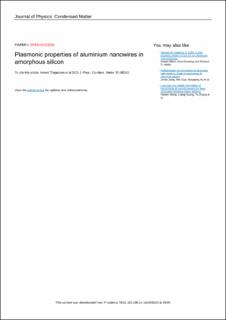| dc.contributor.author | Thøgersen, Annett | |
| dc.contributor.author | Jensen, Ingvild Julie Thue | |
| dc.contributor.author | Belle, Branson Delano | |
| dc.contributor.author | Stange, Marit Synnøve Sæverud | |
| dc.contributor.author | Reinertsen, Vilde Mari | |
| dc.contributor.author | Kjeldstad, Torunn | |
| dc.contributor.author | Prytz, Øystein | |
| dc.contributor.author | Monakhov, Eduard | |
| dc.contributor.author | Kepaptsoglou, Demie | |
| dc.date.accessioned | 2023-02-17T09:00:57Z | |
| dc.date.available | 2023-02-17T09:00:57Z | |
| dc.date.created | 2023-02-08T10:53:38Z | |
| dc.date.issued | 2022 | |
| dc.identifier.citation | Journal of Physics: Condensed Matter. 2022, 35 1-11. | en_US |
| dc.identifier.issn | 0953-8984 | |
| dc.identifier.uri | https://hdl.handle.net/11250/3051814 | |
| dc.description.abstract | Plasmonic structures can help enhance optical activity in the ultraviolet (UV) region and therefore enhancing photocatalytic reactions and the detection of organic and biological species. Most plasmonic structures are composed of Ag or Au. However, producing structures small enough for optical activity in the UV region has proved difficult. In this study, we demonstrate that aluminium nanowires are an excellent alternative. We investigated the plasmonic properties of the Al nanowires as well as the optoelectronic properties of the surrounding a − Si matrix by combining scanning transmission electron microscopy imaging, electron energy loss spectroscopy and electrodynamic modelling. We have found that the Al nanowires have distinct plasmonic modes in the UV and far UV region, from 0.75 eV to 13 eV. In addition, simulated results found that the size and spacing of the Al nanowires, as well as the embedding material were shown to have a large impact on the type of surface plasmon energies that can be generated in the material. Using electromagnetic modelling, we have identified the modes and illustrated how they could be tuned further. | en_US |
| dc.language.iso | eng | en_US |
| dc.publisher | IOP | en_US |
| dc.rights | Navngivelse 4.0 Internasjonal | * |
| dc.rights.uri | http://creativecommons.org/licenses/by/4.0/deed.no | * |
| dc.subject | modelling | en_US |
| dc.subject | EELS | en_US |
| dc.subject | TEM | en_US |
| dc.subject | plasmon | en_US |
| dc.subject | nanowires | en_US |
| dc.title | Plasmonic properties of aluminium nanowires in amorphous silicon | en_US |
| dc.title.alternative | Plasmonic properties of aluminium nanowires in amorphous silicon | en_US |
| dc.type | Peer reviewed | en_US |
| dc.type | Journal article | en_US |
| dc.description.version | publishedVersion | en_US |
| dc.rights.holder | © 2022 The Author(s). Published by IOP Publishing Ltd | en_US |
| dc.source.pagenumber | 1-11 | en_US |
| dc.source.volume | 35 | en_US |
| dc.source.journal | Journal of Physics: Condensed Matter | en_US |
| dc.source.issue | 6 | en_US |
| dc.identifier.doi | 10.1088/1361-648X/aca30e | |
| dc.identifier.cristin | 2124078 | |
| dc.relation.project | Norges forskningsråd: 287729 | en_US |
| dc.relation.project | Norges forskningsråd: 231658 | en_US |
| cristin.ispublished | true | |
| cristin.fulltext | original | |
| cristin.qualitycode | 1 | |

